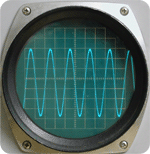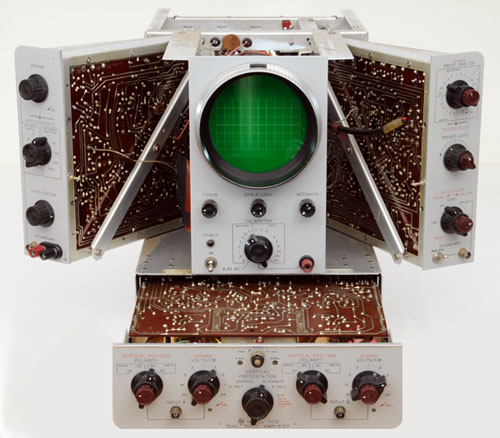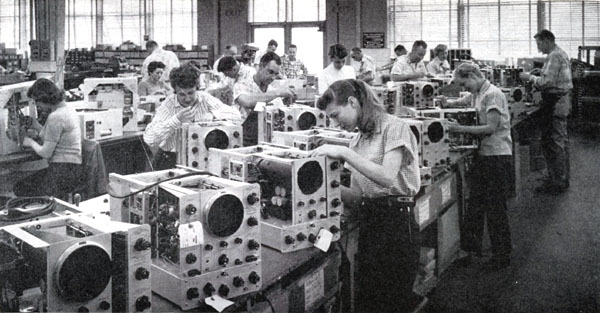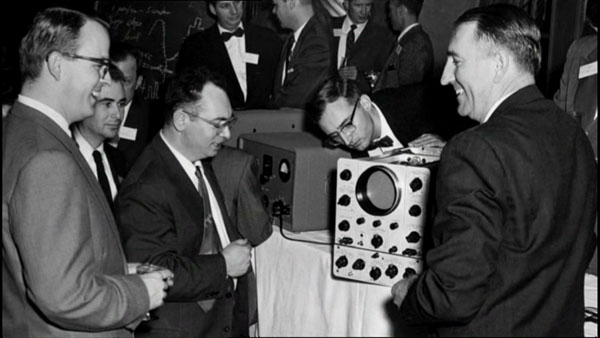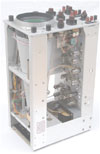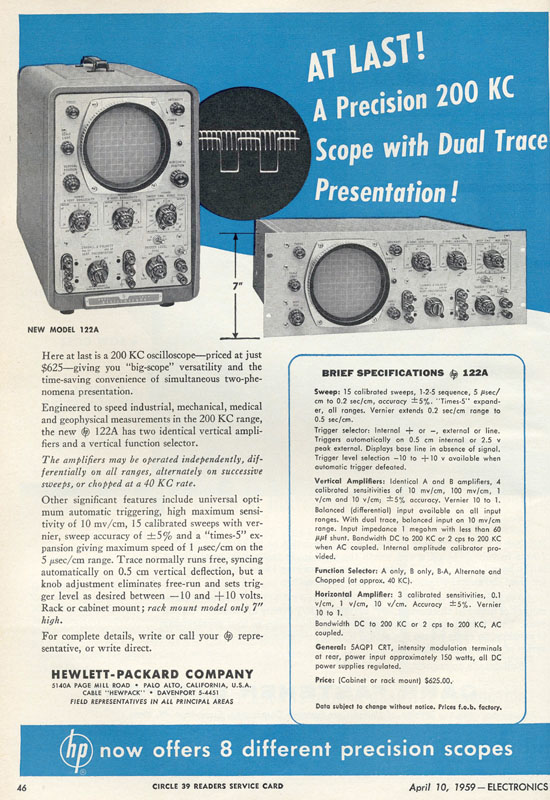HP Oscilloscope . . . not a "Me Too" Product . . .
The begining of oscilloscope production at HP was unusual in the overall company philosphy.
In 1955, sixteen years after the company's birth, the Hewlett-Packard catalog listed nearly 250 measuring instruments of everytype except one -- the oscilloscope!
A small company named Tektronix, shipped its first product in 1947, and was able to match the previous oscilloscope leader, DuMont Laboratories, by 1954 in a nicely growing market. In 1956, Tektronix oscilloscopes were top of the line and the Tektronix Company had built an enviable reputation for superb quality and reliability.
In the early 1950s, most companies did not have their own sales force. Neely Enterprises had been the west coast manufacturer's representative for HP since 1940, and for Tektronix from 1947 to 1953. In 1953 Tektronix established its own sales arm, leaving the distributors without an oscilloscope product. This was the start of a challenge for Norm Neely, the boss of Neely Enterprises, who tried to persuade Bill Hewlett and Dave Packard to add an oscilloscope product line to their catalog. Focus at HP was on the dramatic opportunity in the communications business and Bill and Dave's philosophy was not to build a me-too product. The story does not tell us how Norm Neely was able to convince the duo, but they finally approved a modest oscilloscope development program at HP.
The first two products were the HP 130A and 150A. The 130A was a slick DC to 300 kcs low-frequency scope that filled a niche that Tektronix didn't occupy and the 150A was a 10 Mcs, dual channel plug-in design, which at that time was deemed general purpose.
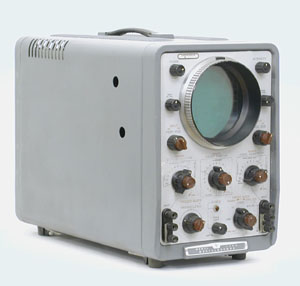 |
The HP 130A Oscilloscope
|
The First HP Oscilloscope, The HP 130A
The 130A was introduced in the March 1956 Hewlett Packard Journal under the title "A New DC-300 KC High-Sensitivity Oscilloscope with Triggered Sweep"
Main Specifications were:
- SWEEP: 1 µsec/cm to 15 sec/cm in 21 calibrated ranges
- SENSITIVITY: 1 mv/cm to 50 V/cm in 14 calibrated ranges
- PASS BAND: DC to 300 kc independent of attenuator setting
- COUPLING: AC or DC - 1 megohm shunted with 50 µµf
- AMPLITUDE CALIBRATOR: 1 kc square wave 5% accuracy
- CATHODE RAY TUBE: 5AQP - 3000 Volts accelerating potential.
- INTENSITY MODULATION: Terminals on rear panel
- PRICE: $450.00 f.o.b. Palo Alto California
Another important characteristic of the 130A was its true XY display capability, the vertical and horizontal amplifiers having the same characteristics, no differential phase shift occured between the two channels. As a result the oscilloscope could readily be used to measure phase shifts in external devices up to 50 kcs.
The 130A's performance perfectly matched the needs of the many HP customers already faithful users of many other HP audio frequency range products. Indeed, the HP 130A did very well in the audio frequency radio manufacturers market, giving HP a very solid, successful audio-video scope product.
Made for Accessibility, and . . . Serviceability, the HP 150A Oscilloscope
Introduced in the April 1956 issue of the Hewlett Packard Journal, the HP150A had a high number of convenient mechanical features. One of these was the physical layout of the instrument. As shown below, on the unit of the HP Memory collection, the instrument is constructed so that sub-assemblies are mounted on swing-out panels. Such an arrangement gives a high order of accessibility to components and wiring.
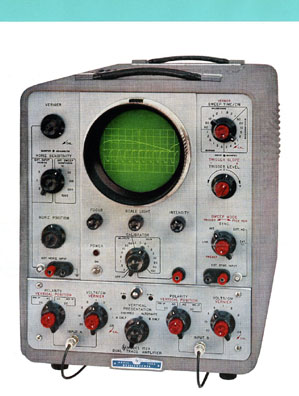 |
The HP 150A Dual Trace 10 Mcs Oscilloscope
Full page of the April 1956 Hewlett Packard Journal
Courtesy of the Hewlett Packard company
|
The 10 Mcs General Purpose Scope
Even if it had, like the 130A the honor of being on the first color pages in the Hewlett-Packard Journal, the 150A didn't have the same success. Built to take on Tektronix in the mainstream high performance market 10 Mcs bandwith, the 150A offered no improvement in speed or cost over the initial Tektronix 511 family introduced nearly a decade earlier.
Main Specifications are:
- SWEEP: 0.02 µsec/cm to 15 sec/cm in 24 calibrated ranges
- SENSITIVITY: 5 mv/cm to 50 V/cm with Model 151A amplifier
- PASS BAND: DC to 10 mc - Rise time less than 0.035 µsec
- COUPLING: AC or DC - 1 megohm shunted with 40 µµf
- AMPLITUDE CALIBRATOR: 18 cal voltages 0.2 mV to 100 V
- CATHODE RAY TUBE: 5AMP - 5000 Volts acceleration
- INTENSITY MODULATION: Terminals on rear panel
- PRICE: 150A Oscilloscope $1000.00 - 151A Amplifier $100.00
For the first time, a non innovatory instrument had been produced at HP. And the worst was the very bad start of the HP vs Tektronix challenge. Much information can be found on the subject in the John Minck narrative. HP would have to wait the beginning of the 60's and the coming of sampling technology to produce competitive oscilloscopes, thanks to step recovery and hot carrier diodes technology internally invented and developed by the HPA component division. Competition between HP and Tektronix would be hard during the following 20 years, with frequent advantages to Tek. Leadership would come back to HP in the mid 1980s, when oscilloscopes would have to talk with computers and became System Scopes. At that time HP took advantage of its experience in computers, and most of all, of the power of its HP-IB (Interface Bus), making oscilloscopes and hundreds of other instruments, all talking to each other and manipulating data with computers.
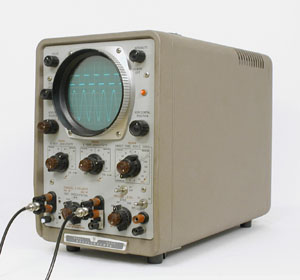 |
The HP 122A Dual Trace Oscilloscope |
The 122A Oscilloscope
The last evolution of the oscilloscope product line before the end of the 50's, the 122A was introduced in the September 1958 Hewlett Packard Journal under the title:
"A Dual-Trace Automatic Base Line Oscilloscope
For the DC - Several Hundred KC Range"
It is a dual-channel version of the 130A which permits two separate waveforms to be viewed simultaneously. To permit an optimum display for a given application, two modes of dual-trace display are available. For the lowest frequency signals the CHOPPED mode will switch electronically between the two vertical amplifiers at a 40 kc rate. For higher-frequency signals the ALTERNATE mode will be preferred to avoid the risk of any harmonic relation between the observed signal and the 40 kc chopping frequency.
To insure stability of the low-level vertical amplifiers, the vacuum tube heaters are voltage regulated. Transistors are used as the control elements in the heater regulator. This makes the 122A one of the very first instruments to integrate transistors in its circuitry.


